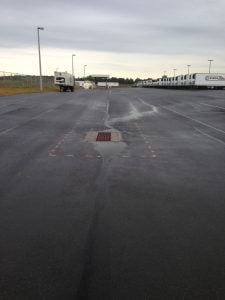Recently, we have seen some extreme temperature fluctuations in our region. While it is not uncommon to see temperature fluctuations during this time of year, we don’t often see days in the low 60’s prior to winter snow storm warnings (like we have seen this week). This can be problematic for your pavement for a couple of reasons.
Following a few consecutive days of 50-60 degree weather, you may have noticed a ton of excess water hanging around on blacktop surfaces coming from the melted snow. This poses several problems:
 Water is deteriorating to asphalt and can easily compromise its structure if it sits too long on its surface. This is particularly true when you are dealing with cracks in your asphalt. With such high volumes of water there is often no place for it all to go, and it is likely that not all will get drained properly, creating large puddles. If the water penetrates the surface of your asphalt structure, and reaches the base, it will begin to compromise your base. Once your base in compromised, this will pose problems for the entire structural support system of your pavement. If the water does not reach your base, it can still cause alarm for your asphalt surface by creating cracks, as well as larger breakage during the freeze-thaw cycle.
Water is deteriorating to asphalt and can easily compromise its structure if it sits too long on its surface. This is particularly true when you are dealing with cracks in your asphalt. With such high volumes of water there is often no place for it all to go, and it is likely that not all will get drained properly, creating large puddles. If the water penetrates the surface of your asphalt structure, and reaches the base, it will begin to compromise your base. Once your base in compromised, this will pose problems for the entire structural support system of your pavement. If the water does not reach your base, it can still cause alarm for your asphalt surface by creating cracks, as well as larger breakage during the freeze-thaw cycle.- As the temperatures fluctuate and reach freezing levels again following a big melt, these puddles will re-freeze, causing hazardous conditions, as well as damages to your pavement, created by the freeze-thaw cycle.
The Freeze-Thaw Cycle:
 Simply put, when water freezes it expands. The technical term for this is volumetric expansion. During the expansion process, water will need about 10% more space in its solid form than it needed in liquid form. If water managed to find its way into any cracks or crevasse, this expansion during the freezing phase will cause pavement damage. As it transitions to a solid mass (needing about 10% more space), it will push outward and upward on the pavement, resulting in a larger crack, or pothole. As the temperatures continue to change from warm to cold, from day to day, this freezing and thawing happens over, and over. This repetition results in greater damage to your asphalt, and more water penetration to its surface and base each time. Find out how a pothole is created HERE.
Simply put, when water freezes it expands. The technical term for this is volumetric expansion. During the expansion process, water will need about 10% more space in its solid form than it needed in liquid form. If water managed to find its way into any cracks or crevasse, this expansion during the freezing phase will cause pavement damage. As it transitions to a solid mass (needing about 10% more space), it will push outward and upward on the pavement, resulting in a larger crack, or pothole. As the temperatures continue to change from warm to cold, from day to day, this freezing and thawing happens over, and over. This repetition results in greater damage to your asphalt, and more water penetration to its surface and base each time. Find out how a pothole is created HERE.
Frost Heave:
Frost heave is also another issue that may arise during days/seasons of temperature fluctuations. Frost heave happens when freezing temperatures penetrate the ground and cause the subsurface water to form ice structures. Again, as it freezes it will expand as well as dry out the surrounding soil, which draws unfrozen water from below the frost front. These temperature fluctuations also impact the depth of a frost front. During frost heave, ice lenses (in between layers of soil) form when moisture diffuses with the soil. As the lenses grow, they cause deformation and upward thrusting of the grounds surface. READ MORE HERE on what frost heave is, and how to prevent it.
Pavement maintenance and preventative measures are extremely important and the most proactive way to maintain your blacktop. Temporary maintenances can help during the winter to keep the problems from getting worse, but come spring, a more permanent pavement repair will need to take place. Now’s the time to start planning for your spring asphalt repairs. Contact EastCoat Pavement Services to begin preparing for spring repairs!



